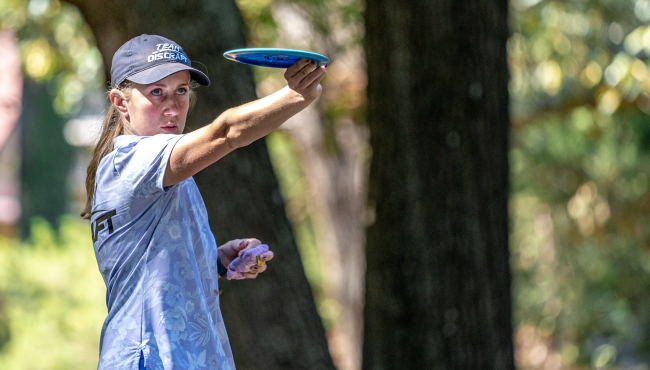Mental Game Coach: Five Elements of Effective Imagery
Mental Game Coach: Five Elements of Effective Imagery
Creating psychological blueprints for success.

Missy Gannon visualizes a shot during the 2020 Women's National Championship. Photo: Alyssa Van Lanen
By Dane Anderson
Have you ever been encouraged by a teammate, parent, or coach to “visualize” success? The theory behind such a directive is that the more you can imagine yourself playing the way you want to, the higher the chances are that the image will come to pass in real life. It is reasonable to believe that having mental pictures of ideal performance can provide athletes with a target to aim for during competition. The question is, how do you actually create these pictures whenever or wherever you need to?
Imagery is the process through which an athlete constructs an imaginary picture, a psychological blueprint of sorts, of executing skills critical to success. For example, a disc golfer may imagine sinking a 40-foot putt in a critical point in the round or throwing a phenomenal drive through a series of trees and bushes to set up the next shot nicely. Such images have three purposes:
- Provide a plan of action heading into the shot.
- Inspire confidence in one’s abilities.
- Decrease physical symptoms of anxiety (rapid heart rate, perspiration, trembling hands) and increase focus.
Imagery, however, goes beyond visualization. Effective psychological blueprints for success include five components:
- Visual – What do you see unfolding in the image?
- Auditory – What do you hear in the image?
- Kinesthetic – What do you physically feel in the image?
- Emotional – What are your emotional reactions to the image?
- Control – How well can you dictate the outcome of the image?
These five elements of effective imagery help your mind create a vivid, lifelike representation of how you intend to play the game. They make your images congruent with lived experience and can thus translate to improvement on the course.
It is helpful to start building images incorporating one of the five elements of imagery at a time. For example, if you know you are visually inclined when you use your imagination, start there. Set the scene imagining what you might see on the course. Then, add in the kinesthetic sense. How would this moment physically feel? Work your way down the list. There is no one “right” way to build images, just incorporate the elements in a sequence that best suits your intellectual creativity.
What if you don’t know which imagery components are your strongest? Here are four scenarios to test your imagery abilities:
Scenario 1: Imagine yourself practicing disc golf in a familiar place where you practice most often, without anyone present. Close your eyes for one minute and imagine seeing, hearing, feeling, and experiencing the emotions of this practice session as vividly as possible.
Scenario 2: Imagine yourself practicing in the same place, but with at least two other people present. This time, you miss an easy shot that you normally make without much difficulty. Now imagine yourself trying the shot again, this time successfully, while the other people are still present. Close your eyes for one minute and imagine seeing, hearing, feeling, and experiencing the emotions of this situation as vividly as possible.
Scenario 3: Imagine a competitor or teammate making a successful shot at a pivotal point in the round. Close your eyes for one minute and imagine seeing, hearing, feeling, and experiencing the emotions of this situation as vividly as possible. Your only role in this image is to be aware of your own physical presence.
Scenario 4: Imagine yourself performing well under pressure during a tournament. Imagine those around you cheering and celebrating your success. Close your eyes for one minute and imagine seeing, hearing, feeling, and experiencing the emotions of this competition as vividly as possible.
For each scenario, rate your imagery abilities by using a scale of 1 to 5 (1 = I did not get this element of the image clearly at all, 5 = I imagined this part of the image as clearly as possible). Your scores will reveal your imagery strengths and growth edges as you consider building your own mental pictures of your best, most resilient performance.
- I saw myself clearly during this scenario:
- I heard the sounds of this image clearly:
- I physically felt the movements of this image:
- I was aware of my mood and emotions in this image:
- I was able to control how this image unfolded:
To practice imagery, it is helpful to spend 5-10 minutes each day imagining the scenarios you are most likely to encounter on the course. You can use these images the night before a big tournament, as you warm up before the round begins, or right before you attempt a shot. Notice how your confidence grows as you build your imagery skills, enhancing the images with all five components. The positive pictures you create can help you replace the negative ones that arise from fear of failure or previous poor performance. Adopt a growth mindset by committing to regular imagery practice and see what happens to your game.
Dane Anderson is a doctoral candidate offering sport psychology and mental skills training services to athletes looking to improve their mental game. He teaches skills including goal-setting, self-talk and imagery. Contact him at [email protected] or call 541-414-4289
- posted 1 week ago
- posted 2 weeks ago
- posted 2 weeks ago
- posted 2 weeks ago
- posted 2 weeks ago
- ‹ previous
- 2 of 731
- next ›
- posted 5 years ago
- posted 5 years ago
- posted 5 years ago
- posted 5 years ago
- posted 5 years ago
- ‹ previous
- 2 of 3
- next ›
